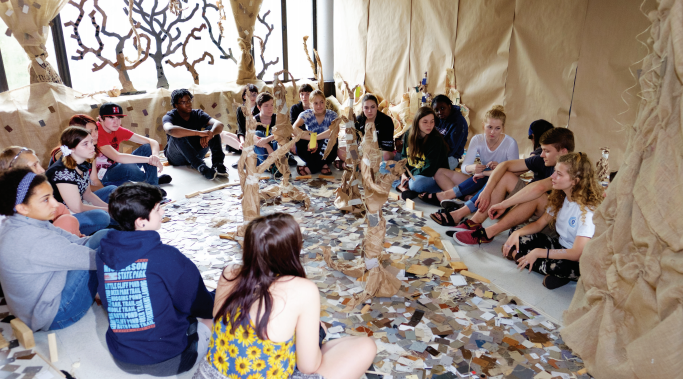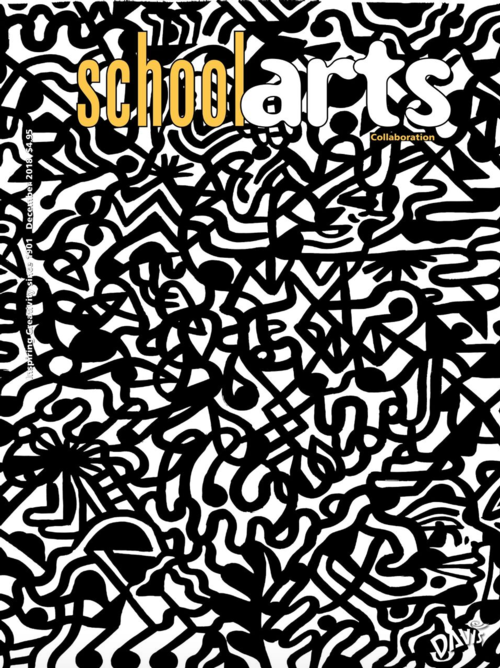AAS Beginnings
AAS began when art teachers in Massachusetts identified a need to create opportunities for high-school students to interact with professional artists as a way to understand what it’s like to be an artist working and living in the world today. It also provides exposure to contemporary art and practices in a way that students are not able to receive in a traditional classroom setting. Our tagline is “Limits: No Limits” because we believe that, given limited time and resources, when we work together, the possibilities are limitless.
Collaborative Community
The notion of “collaborative creative community” runs like a life-line through all aspects of AAS. It provides a shared, lived experience that connects participants, artists, educators, and community members regardless of the year they attended or their specific group project. Successful community building relies on successful community partnerships. At its core, AAS is a partnership between the Massachusetts Art Education Association and the College of Visual and Performing Arts at UMass Dartmouth who find in AAS a way to achieve common goals.
The Location
While attending AAS, the groups visit the New Bedford Art Museum/Artworks!, the New Bedford Free Public library, the New Bedford Whaling Museum, and the New Bedford Whaling National Historical Park, along with the city’s wonderful galleries, and many public art pieces and murals. With all of the interesting things to explore, it’s hard not to be inspired!

Pit-Fowls temporary tape art installation at the CVPA building, UMass Dartmouth, created for AAS by the Tape Art Crew
Facilitating Collaborations
AAS is strongly committed to serving adolescents and helping them understand the role of art in their individual lives and in the life of the community. The 144 students selected work with sixteen professional artists to create large-scale installations in thirty-six hours using a limited number of materials. Students work in groups of eighteen with two artist mentors per studio group. Each group examines, discusses, and investigates works from local galleries and museums to inspire their collaborative work.
Artist Mentor Training
The artist mentors attend a full day of training before student participants arrive. The artist mentors collaborate from the start, sharing their own creative paths along with their current work and interests. From there, the artist mentors go through a series of engagement activities while learning about the current exhibitions and public works available as inspiration for their work with student participants.
The program director and members of the steering committee, who have extensive experience working with teens, facilitate collaborative experiences for the artist mentors as
a way to model how they can facilitate similar engagement experiences with their student groups. Guiding, supporting, focusing, and delegating are key to making the collaborative installations come together. Assisting the group in decision-making ensures that all voices in the group are heard.
The Tape Art Crew
In addition, Michael Townsend, Leah Smith, and the Tape Art Crew will use tape to create a temporary drawing on the UMass Dartmouth campus that explores a contemporary theme. The group also holds a public talk about their collaborative work to reinforce the connections between creating collaborative public art and that of the students participating in AAS.
Lasting Impact
In our thirty-plus years, AAS has had many participants tell us that this a truly life-changing experience. Since focusing on twenty-first century skills that are transferrable to many aspects of life—collaboration, community, creative problem-solving, and contemporary themes—we have found that these are the components that stay with the participants long after the two days have passed.
The impact is enduring for student participants who attend at a pivotal time in their lives when they are making important decisions about their future. AAS aims to assist in this process by providing a small taste of what it’s like to engage as part of a creative community. The energy and enthusiasm of the two days does not end there—it is carried back to the school classrooms, throughout our state, and back with our artists who often go on to collaborate with each other on future projects. Ultimately, everyone involved is left with knowing that possibilities and potential are truly limitless.
Kristi Oliver is assistant professor of art education at the University of Massachusetts Dartmouth. artallstate@umassd.edu
View this article in the digital edition.


